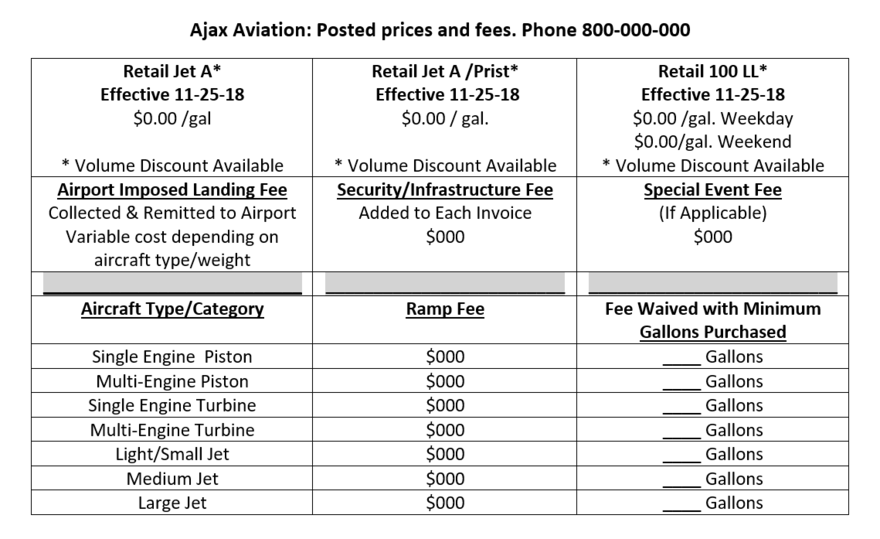Get Ready to Post Fuel Prices and Other Fees
/Six aviation associations are encouraging FBOs and aviation service organizations to be more open and transparent about fuel prices, fees and charges.
The AOPA, EAA, GAMA, NATA, NBAA and HAI recently endorsed a document recommending “Know Before You Go” best practices designed to guide FBOs in making their fuel pricing and other fees known to aircraft owners and operators. The industry groups call for FBOs to provide “a description of available services and a listing of current applicable retail fuel prices, fees and charges. This includes FBO fees and charges for services, pre-planned special events, infrastructure, facility, ramp, parking, handling, and security, as well as airport pass through fees.”
Although many FBOs currently post their retail fuel prices through various online services, the declaration recommends going further. It calls for FBOs to participate voluntarily and to make this information openly available to aircraft owners and operators via online postings and through customer phone inquiries.
Visibility and openness in the FBO business are themselves industry best practices. These qualities come with the realization that FBOs and aircraft owners and operators need each other in the best possible way. It is very much a symbiotic relationship.
For the FBO, the goal should be to provide the best customer experience possible. By being open and transparent with pricing and fees, the process of developing trust begins and will result in helping to build long-term profitable customer relationships.
The “Know Before You Go” declaration is a good and reasonable effort to let customers know what FBOs will charge for services rendered.
We recommend making it easy for customers by posting fuel prices and other fees on your company’s web site. To help with this process, the following is a sample template we created for our fictional Ajax Aviation FBO:
 FBOs may follow this example to communicate fuel prices and fees in a simple format.
FBOs may follow this example to communicate fuel prices and fees in a simple format.
A simple chart is best. Build it so pricing and fees can easily be modified, and keep it updated at least once a month or sooner if pricing changes. Do not try to give too much information, such as volume discount schedules, landing fees based on aircraft weight or other complex tables.
It is also important that FBOs do their best to inform and educate the customer with regards to the cost of doing business. If an aircraft arrives on an FBO ramp and doesn’t take any fuel, an FBO incurs ongoing costs including labor, airport lease payments, flowage fees, utilities, security, facility upkeep and various liability insurance costs.
We suggest FBOs include some of these points printed on a small folder that holds the customer’s receipt. Also, posting subtle reminders in key lounge areas as well as crew cars helps reinforce the message. For instance, “This crew car is provided as a courtesy, and we would like to thank our loyal customers for purchasing fuel and other services.”
Please leave any comments you have about this blog post below. If you have any questions, please give us a call or send us an email: jenticknap@bellsouth.net, 404-867-5518; ronjacksongroup@gmail.com, 972-979-6566.
ABOUT THE BLOGGERS:
John Enticknap has more than 35 years of aviation fueling and FBO services industry experience and is an IS-BAH Accredited auditor. Ron Jackson is co-founder of Aviation Business Strategies Group and president of The Jackson Group, a PR agency specializing in FBO marketing and customer service training. Visit the biography page or absggroup.com for more background.
SUBSCRIBE:
Subscribe to the AC-U-KWIK FBO Connection Newsletter
© 2018 ABSG
